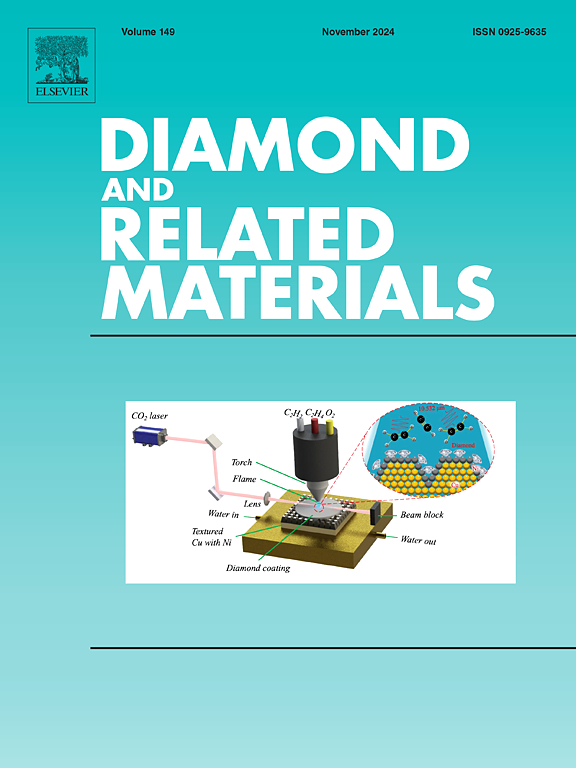Effect of surfactant on the microstructure and microwave-absorbing properties of helical carbon nanotubes/doped barium ferrite composites
IF 5.1
3区 材料科学
Q2 MATERIALS SCIENCE, COATINGS & FILMS
引用次数: 0
Abstract
Doped barium ferrite/helical carbon nanotube composites were prepared using a sol-gel method. The microstructure of doped barium ferrite/helical carbon nanotube composites treated with different surfactants was analyzed using scanning electron microscopy, Nanoparticle potentiometer, specific surface and porosity analyzer, ultraviolet-visible spectrometer, cold field emission scanning electron microscope, and X-ray diffraction. The electromagnetic parameters and absorption properties of the composites were analyzed using a vector network analyzer, and the enhancing mechanism of the absorption properties of doped barium ferrite/helical carbon nanotube composites was studied. The results show that the barium ferrite particles and carbon nanotubes in the composite material are overlapped through the sheet-line and sheet-sheet interactions, which results in a rich microcavity structure and a good conductive network. The composites treated with sodium dodecyl sulfate (SDS, 10 g/L) exhibit good potential difference and system stability due to the combination of electrostatic repulsion, van der Waals attraction, space repulsion, and vacancy repulsion. The composite treated with SDS exhibits the strongest return loss (−56.84 dB at 3.12 GHz with a matching thickness of 3.12 mm) among all composites. It also has a wide absorption frequency band of 6.34 GHz, which covers the Ku band with a matching thickness of only 1.44 mm. The main loss mechanisms are polarization relaxation, multiple scattering of electromagnetic waves, conduction loss, natural resonance, and domain wall resonance.

表面活性剂对螺旋碳纳米管/掺杂钡铁氧体复合材料微观结构和吸波性能的影响
采用溶胶-凝胶法制备了掺杂钡铁氧体/螺旋碳纳米管复合材料。采用扫描电镜、纳米粒子电位器、比表面和孔隙率分析仪、紫外可见谱仪、冷场发射扫描电镜和x射线衍射分析了经不同表面活性剂处理的掺杂铁氧体钡/螺旋碳纳米管复合材料的微观结构。利用矢量网络分析仪分析了复合材料的电磁参数和吸收性能,研究了掺杂钡铁氧体/螺旋碳纳米管复合材料吸收性能的增强机理。结果表明,复合材料中的钡铁氧体颗粒与碳纳米管通过片线相互作用和片层相互作用相互重叠,形成了丰富的微腔结构和良好的导电网络。十二烷基硫酸钠(SDS, 10 g/L)处理后的复合材料由于静电斥力、范德华引力、空间斥力和空位斥力的共同作用,表现出良好的电位差和体系稳定性。经SDS处理的复合材料在3.12 GHz处回波损耗最大(−56.84 dB,匹配厚度为3.12 mm)。它还具有6.34 GHz的宽吸收频带,覆盖了Ku波段,匹配厚度仅为1.44 mm。损耗机制主要有极化弛豫、电磁波多次散射、传导损耗、自然共振和畴壁共振。
本文章由计算机程序翻译,如有差异,请以英文原文为准。
求助全文
约1分钟内获得全文
求助全文
来源期刊

Diamond and Related Materials
工程技术-材料科学:综合
CiteScore
6.00
自引率
14.60%
发文量
702
审稿时长
2.1 months
期刊介绍:
DRM is a leading international journal that publishes new fundamental and applied research on all forms of diamond, the integration of diamond with other advanced materials and development of technologies exploiting diamond. The synthesis, characterization and processing of single crystal diamond, polycrystalline films, nanodiamond powders and heterostructures with other advanced materials are encouraged topics for technical and review articles. In addition to diamond, the journal publishes manuscripts on the synthesis, characterization and application of other related materials including diamond-like carbons, carbon nanotubes, graphene, and boron and carbon nitrides. Articles are sought on the chemical functionalization of diamond and related materials as well as their use in electrochemistry, energy storage and conversion, chemical and biological sensing, imaging, thermal management, photonic and quantum applications, electron emission and electronic devices.
The International Conference on Diamond and Carbon Materials has evolved into the largest and most well attended forum in the field of diamond, providing a forum to showcase the latest results in the science and technology of diamond and other carbon materials such as carbon nanotubes, graphene, and diamond-like carbon. Run annually in association with Diamond and Related Materials the conference provides junior and established researchers the opportunity to exchange the latest results ranging from fundamental physical and chemical concepts to applied research focusing on the next generation carbon-based devices.
 求助内容:
求助内容: 应助结果提醒方式:
应助结果提醒方式:


